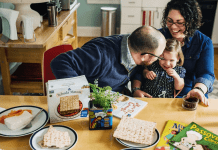My husband and I have walked into my late mother-in-law’s house for the last time.
We are in the process of settling her estate, including the sale of her house and disposition of everything in it.
From a hutch filled with china and crystal goblets to overflowing jewelry boxes and coin collections. And everything in between.
A lot in between.
Her clothes. The Notre Dame sweaters my late father-in-law was so fond of wearing. Her furniture. Furniture inherited from her mother-in-law, still in the same place in the garage where it was originally placed 30 some-odd years ago. My husband’s Cub Scout uniform. Christmas decorations. Lots and lots of Christmas decorations.
Every room, every closet, every shelf, every drawer. Full of stuff. A lifetime of stuff. Two lifetimes, if you count my father-in-law, who passed away 11 years ago.
What to Do With a Lifetime of Stuff
My mother-in-law was a neat and tidy housekeeper. But like many of us (myself included), she lived in a good-sized house with plenty of room to accommodate stuff. Things inherited from her parents and her in-laws. The broken vacuum cleaner waiting for repair in the back of the closet. Hundreds of books read once. You get the picture.
And the cost of disposing of all of that stuff? Having the estate sale company we hired go through every room, every closet, every drawer, separating the trash from the treasures, may cost more than will be generated at the eventual estate sale.
Her house has been transformed into a store, the estate sale company having cleverly arranged and displayed my mother-in-law’s possessions on tables in every room.
All of her possessions with any value, save the very few we kept, each with a tiny white price tag.
Losing your last surviving parent is hard enough. But being the arbiter of which of your parents’ and grandparents’ treasures get saved and which end up sold, donated, or in a landfill? gut-wrenching.
The lesson we have learned from this experience?
Most of the stuff in your house is worthless. And eventually, someone, either you or your kids, will be tasked with the overwhelming job of getting rid of it.
Most of Your Stuff Is Worthless
Most of the stuff in your house is worthless.
Yes, even the stuff you worry the most about, the stuff you think is so good you don’t use it for fear of breaking it, has little to no resale value.
From china, china cabinets, crystal goblets, silver tea sets, pianos, and collectible figurines like Hummels, to grandfather clocks and real pieces of craftsmanship furniture.
Why? Baby boomers have glutted the market with their castoffs, and millennials, the next generation of buyers, don’t want it.
Millennials hate both formal in-home entertaining and use of second-hand goods. With looming student loans, they tend to rent and move often. Who wants to be constantly moving a piano and a grandfather clock from apartment to apartment?
And furniture? There’s no market for so-called “brown furniture,” meaning any furniture (regardless of quality) other than the “mid-century casual” furniture (think clean, lightweight) favored by millennials. Brown furniture is basically firewood.
If it’s not in great condition, it’s also not fit for donation because it can’t be resold.
All of my mother-in-law’s furniture (including the pieces inherited from her mother-in-law and kept for decades)? Straight to the landfill.
Well, Almost Everything…
What do guns, LPs (records), and precious metals/gems have in common?
They are 3 things you might have in your house with a robust resale value.
Silverware also has value, but only if it is real silver and can be melted down.
3 Things You Should Be Doing NOW to Reduce the Amount of Stuff You Have
1. Be viciously thoughtful about holding onto sentimental items.
Here was our goal with sorting through my mother-in-law’s things. Keep just enough to remind us of her, but not so much stuff that our daughters are going to be dealing with it 40 some-odd years from now.
Here’s what we kept:
- A painting to be displayed in our dining room
- My mother-in-law’s treasured Swarovski crystal animal collection (all of which were given to her by her children and grandchildren over the years)
- Jewelry to be divided among the granddaughters
- Each of our daughters got to select 1 item
And that was it.
Well, almost. We did set aside photos to be digitized (with the originals then destroyed).
Was it hard leaving everything else? You bet it was. But we don’t want to be dealing with a lot of stuff years from now (or worse, leaving it to our daughters to deal with).
I try to be viciously thoughtful with my own sentimental items. For example, I don’t save any school papers or art projects from my kids (though I do take photos of my favorites).
2. Buy fewer books.
While used book resellers like Half Price Books do an important service in keeping books in circulation, a surprising number of books end up in landfills because many paper recycling facilities can’t process the the glue that binds book spines.
My resolution last year was to cut down on my book consumption by only reading books that I borrow from the library or purchase on my Kindle e-reader. If you haven’t used a library in years, now is the time to go back. My local library has an app where you can “order” books online, and pick them up the next day on a special “hold” shelf strategically placed next to the check-out kiosk.
How successful was I on my resolution? I read 1 to 2 books a week in 2019, only 1 of which was a hard copy purchased from Amazon.
3. Buy fewer, but better quality, clothes
The world is overflowing with used clothing.
We buy substantially more clothing over our lifetimes than our grandparents did.
Clothing made today is meant to last no more than a few years. In fact, a lot of clothing isn’t even made to withstand more than a few washes.
Think you are “paying it forward” but dropping off a load of unwanted clothes at Goodwill? Think again. Most clothing donations never make it to the racks at Goodwill and only about a third of what does eventually sells.
To really pay it forward, cut down on the amount of clothing you have by buying better quality clothes that last longer.
Keeping What Really Matters
My 5-year-old chose to keep a Christmas music box from her Grandma’s house. It plays “White Christmas” and has tiny ice skaters going around a rink inside. Each Christmas, my mother-in-law would bring out this music box and let each of her granddaughter’s play with it. It’s value in preserving a precious memory of Grandma? Priceless.














Have a 10×30 storage unit in Ashburn Va still filled with items I decided to keep from my former home of 38 years. After giving it a lot of thought the past couple months, I’ve decided that I still have way too much “stuff”, and have decided to sell most of the quality items/furniture for pennies-on-the-dollar until
it’s (the unit) is empty. This “estate sale” will start Sat, Feb 1st, 2020 on an appt only basis (due to co. policy) and run thru the month, weather permitting. Some pix available and more to come as access becomes available.
A precursor to decluttering is the belief that one will remain economically agile; those generations who have lived war experience or encampment experience do not waste fully discard.There is an option of repurpose or reuse for nearly everything; it just involves thinking outside the square: eg teapots can be hung in garden as bird feeders: old plates used for mosaic work, old books for folded book workshops, old furniture for milk painting classes, metal objects can be rust finish painted for garden sculpture ornaments, old clothing can be donated for rag rug making; cut into strips and knotted together.If each generation does their bit the issue will be easier.
“Well, almost. We did set aside photos to be digitized (with the originals then destroyed).“
Huge mistake! Original photo paper prints will last forever! Digital files go obsolete with each new technology, who can foresee what digital technology will exist in 20, 50, 75 years?
This was so well written with the passion from someone who recently lost some very dear family members, along with their belongings. Mostly, the sadness of loss surfaced with some sound suggestions about the reality of the follow-up tasks attached to that loss. There are some thoughtful ideas to consider, but will we all change our buying habits? Time for reflection.
I have found Guild resale stores a good place to sell my used clothing and household items no longer used. They also will take furniture. Money in my pocket.
Thank you for this excellent article! Shared! I particularly appreciate your note that the cost of the pulling things together for an estate sale will likely exceed the return. After my own experience with my parent’s estate, I shared my story in “The Stories We Leave Behind”. The book is available for purchase but more importantly it is in libraries across the US and Canada.
This author is insane. My X generation kids are fighting over my brown all cherry Queen Anne pieces from Ethan Allen that I purchased in the 80s and 90s. Including the grandfather clock that took a year to have made.
We X-Gen’ers still value many of the pieces of “brown furniture” and the like that we grew up with but as the parent of millennials, I can attest to their minimalism and disinterest in “brown furniture” and collectibles. The good news was that it meant my daughter was particularly helpful/brutal when we downsized!
I think it is a shame that children , as you say will use a inheritance antique piece of furniture as firewood. This is so sad. They want things from overstock. Com that is cheaply made and WHITE. When did everything have to be white? The house , kitchen , and furniture all white. Absolutely no appreciation for any furniture that tells a story. My mother’s crystal and my china are beautiful but no one wants it. I’m heartbroken about this generation of young adults. It is a throw away disposal society of ingrates.
Agreed! But I know millennials like IKEA better than the good brown good stuff. One day they ll change after at far settle into a good home and don’t wNt to buy their 3rd sofa in 6/7 years.